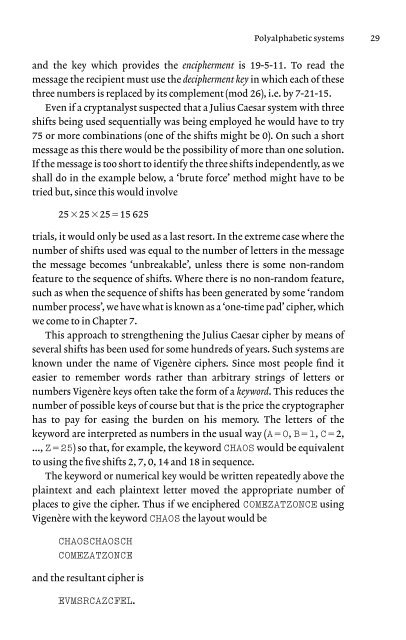Code and ciphers: Julius Caesar, the Enigma and the internet
Code and ciphers: Julius Caesar, the Enigma and the internet
Code and ciphers: Julius Caesar, the Enigma and the internet
Create successful ePaper yourself
Turn your PDF publications into a flip-book with our unique Google optimized e-Paper software.
<strong>and</strong> <strong>the</strong> key which provides <strong>the</strong> encipherment is 19-5-11. To read <strong>the</strong><br />
message <strong>the</strong> recipient must use <strong>the</strong> decipherment key in which each of <strong>the</strong>se<br />
three numbers is replaced by its complement (mod 26), i.e. by 7-21-15.<br />
Even if a cryptanalyst suspected that a <strong>Julius</strong> <strong>Caesar</strong> system with three<br />
shifts being used sequentially was being employed he would have to try<br />
75 or more combinations (one of <strong>the</strong> shifts might be 0). On such a short<br />
message as this <strong>the</strong>re would be <strong>the</strong> possibility of more than one solution.<br />
If <strong>the</strong> message is too short to identify <strong>the</strong> three shifts independently, as we<br />
shall do in <strong>the</strong> example below, a ‘brute force’ method might have to be<br />
tried but, since this would involve<br />
25�25�25�15 625<br />
trials, it would only be used as a last resort. In <strong>the</strong> extreme case where <strong>the</strong><br />
number of shifts used was equal to <strong>the</strong> number of letters in <strong>the</strong> message<br />
<strong>the</strong> message becomes ‘unbreakable’, unless <strong>the</strong>re is some non-r<strong>and</strong>om<br />
feature to <strong>the</strong> sequence of shifts. Where <strong>the</strong>re is no non-r<strong>and</strong>om feature,<br />
such as when <strong>the</strong> sequence of shifts has been generated by some ‘r<strong>and</strong>om<br />
number process’, we have what is known as a ‘one-time pad’ cipher, which<br />
we come to in Chapter 7.<br />
This approach to streng<strong>the</strong>ning <strong>the</strong> <strong>Julius</strong> <strong>Caesar</strong> cipher by means of<br />
several shifts has been used for some hundreds of years. Such systems are<br />
known under <strong>the</strong> name of Vigenère <strong>ciphers</strong>. Since most people find it<br />
easier to remember words ra<strong>the</strong>r than arbitrary strings of letters or<br />
numbers Vigenère keys often take <strong>the</strong> form of a keyword. This reduces <strong>the</strong><br />
number of possible keys of course but that is <strong>the</strong> price <strong>the</strong> cryptographer<br />
has to pay for easing <strong>the</strong> burden on his memory. The letters of <strong>the</strong><br />
keyword are interpreted as numbers in <strong>the</strong> usual way (A�0, B�1, C�2,<br />
..., Z�25) so that, for example, <strong>the</strong> keyword CHAOS would be equivalent<br />
to using <strong>the</strong> five shifts 2, 7, 0, 14 <strong>and</strong> 18 in sequence.<br />
The keyword or numerical key would be written repeatedly above <strong>the</strong><br />
plaintext <strong>and</strong> each plaintext letter moved <strong>the</strong> appropriate number of<br />
places to give <strong>the</strong> cipher. Thus if we enciphered COMEZATZONCE using<br />
Vigenère with <strong>the</strong> keyword CHAOS <strong>the</strong> layout would be<br />
CHAOSCHAOSCH<br />
COMEZATZONCE<br />
<strong>and</strong> <strong>the</strong> resultant cipher is<br />
EVMSRCAZCFEL.<br />
Polyalphabetic systems 29

















